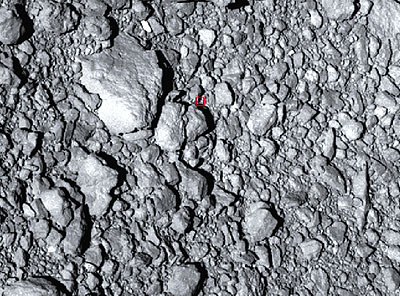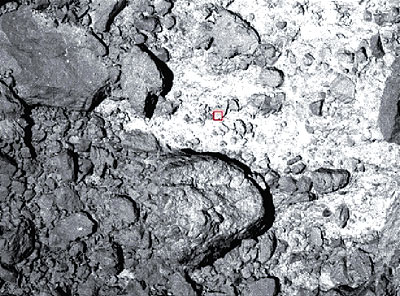TOP > Report & Column > The Forefront of Space Science > 2007 > Understanding of the Solar System through Research of Minor Bodies - Bridging Groundbased-Observation and Meteorite-Analysis Research -
![]()

Formation process of Itokawa Based on the above insights, the formation process of Itokawa is presumed to be as follows. Itokawa’s rock material formed in the early phase of solar system formation. We believe that the material had similar features to those of ordinary chondrites that we can now see. Later, the asteroid experienced several collisions with other objects. After the catastrophic collisions, scattered pieces of the asteroid accumulated again and formed the current Itokawa. Large-scale melting or composition differentiation, however, did not take place with Itokawa. On the other hand, we guess that the voids were left between pieces at reaccumulation, forming the current Itokawa with low density as a whole. It is still uncertain when the differences in color and brightness on the surface were created. Judging from closeup images of Itokawa, it is guessed that the bright areas initially existed under the rocks forming the dark areas and, then, as the dark rocks moved to other places, the bright areas were eventually exposed. It is surprising that material movement took place even in a small body like Itokawa. In the groundbased observation, Itokawa’s surface was viewed as only one point integrating all the areas. The above findings were first discovered by spatially resolved observation conducted at a close approach to Itokawa. Does it answer the question about the relation of S-type asteroids to ordinary chondrites? A concept called the “space weathering” {(c) in the abovementioned hypotheses} is now thought to answer the longtime question of the relation of S-type asteroids to ordinary chondrites. The surfaces of celestial bodies without atmosphere like asteroids are always exposed to solar wind and collisions with micro-meteorites. Ground tests simulating these circumstances are now underway. Lately, it became clear that spectroscopic features of surface materials are changed by such space weathering. The fact that the effect takes place with asteroids was suggested by observations from, for example, the NEAR Shoemaker mission. More tangible evidence of space weathering was discovered on Itokawa’s surface (Fig. 3) by HAYABUSA’s highly spatially resolved observation, which explains the features of the effect. HAYABUSA’s data show that the features of the bright and dark areas are very similar to those of space weathering. Further, the brighter areas are fresher than the dark areas and their spectroscopic features are closer to those of ordinary chondrites. Whether or not our supposition is correct will depend on the final results of the HAYABUSA mission. If the explorer succeeded in collecting samples of Itokawa’s surface and returns them to earth, we can analyze them to verify our supposition. Nonetheless, with HAYABUSA’s close observations of the asteroid, many points have been clarified that could not be uncovered by groundbased observations.  
Explorations following HAYABUSA While HAYABUSA provided us with many new facts on S-type asteroids, there are many other types of asteroids in the solar system. We expect a series of explorations in the future: next is C-type asteroids, most of which are likely to be located at further regions from the Sun compared to the S-type, then D-type asteroids located beyond C-type, and finally, the trans-Neptunian objects that are located beyond the orbit of Pluto. With these explorations, we can obtain information on material distribution in the early stage of the whole solar system and, at the same time, advance our understanding on minor bodies in the solar system. In addition, we hope that research on the origin and evolution of the solar system, which has been driven by groundbased observations and meteorite analysis (and, naturally, including contributions from theoretical and experimental research), will be combined with new information brought by explorers of the solar system’s minor bodies, eventually advancing our comprehensive understanding. (Masanao ABE)
|
||||||||||




